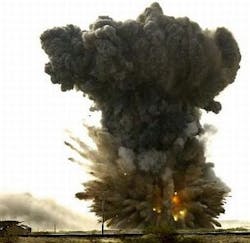DARPA asks Northeastern University to detect IEDs hidden in mud, meat, and dead animals
ARLINGTON, Va., 24 April 2013.Improvised explosive device (IED) experts at Northeastern University in Boston are joining three other research organizations in a project to develop non-contact ways to detect explosives hidden in opaque media with high water content such as mud, meat, and animal carcasses.
Northeastern is joining Quasar Federal Systems in San Diego; the University of Arizona in Tucson, Ariz.; and BAE Systems in Arlington, Va., on the Methods for Explosive Detection at Standoff (MEDS) program of the U.S. Defense Advanced Research Projects Agency (DARPA) in Arlington, Va.
DARPA awarded Northeastern two contracts last week -- one for $467,755 and the other for $238,381 -- for different parts of the MEDS program. Previously Quasar won a $1.8 million contract; University of Arizona won a $1.5 million contract; and BAE Systems won a $427,003 contract in February, March, and April.
Because detection and imaging methods have not been developed or applied to this non-contact ways to detect explosives hidden in opaque media with high water content, DARPA scientists are asking the three organizations to develop a proof-of-concept program with emphasis on demonstration. Development of instruments for deployment in operational environments are not part of this program.
Essentially, DARPA scientists are asking the organizations to find ways of detecting hidden explosives in much the same way that doctors detect breast cancer.
The DARPA MEDS program seeks is asking the four organizations find ways of rapidly detecting bulk explosives embedded within an opaque medium with high water content. This will preclude the use of trace detection methods and bulk methods where significant penetration into the medium is not possible, DARPA researchers say.
As an extra challenge in the MEDS program, DARPA scientists are asking participants not to use ionizing radiation, other than possible employment of backscatter technology, in the MEDS program because of health concerns to military personnel and civilians.
DARPA is asking the four organizations to work on recognition of abnormalities in complex high-water-content media that can be performed with no physical contact with the surface of the host medium.
DARPA experts are interested in technologies such as mixed modality mechanisms that use electromagnetic indicators and acoustic vibration, x-rays, and non-ionizing detection methods. Approaches that rely on x-rays with minimal ionizing radiation exposure may be of potential interest.
For more information contact Northeastern University online at www.northeastern.edu, or DARPA at www.darpa.mil.

